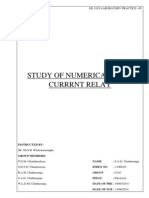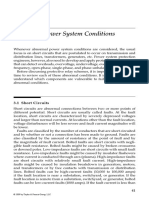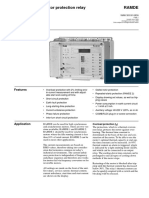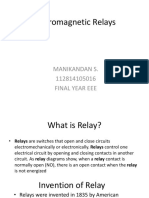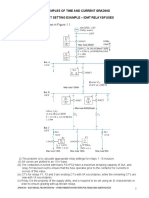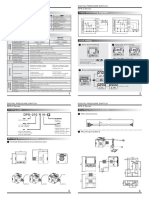Protection - of - Rotating - Machinery - Intro and Problems
Uploaded by
moses kakwenaProtection - of - Rotating - Machinery - Intro and Problems
Uploaded by
moses kakwenaChapter 7: Rotating Machinery Protection
7.1 Introduction
The protection of rotating equipment involves the consideration of more possible failures or abnormal operating
conditions than any other system element. Although the frequency of failure, particularly for generators and large
motors, is relatively low, the consequences in cost and system performance are often very serious. Paradoxically,
despite many failure modes that are possible, the application principles of the protection are relatively simple. There
are none of the complications requiring a pilot scheme. Those failures involving short circuits are usually detected by
some type of differential or overcurrent relay. Many failures are mechanical in nature and use mechanical devices
such as limit, pressure or float switches, or depend upon the control circuits for removing the problem. 1,2
Some of the abnormal conditions that must be dealt with are the following.
1. Winding faults:
o stator — phase and ground fault
2. Overload
3. Overspeed
4. Abnormal voltages and frequencies.
For generators we must consider the following.
5. Underexcitation
5. Motoring and startup.
For motors we are concerned with the following.
7. Stalling (locked rotor)
8. Single phase
9. Loss of excitation (synchronous motors).
There is, of course, some overlap in these areas, particularly in overloads versus faults, unbalanced currents and
single phasing, etc. Thus, relays applied for one hazard may operate for others. Since the solution to a given failure
or abnormality is not the same for all failures or abnormalities, care must be taken that the proper solution is applied
to correct a specific problem. In some instances tripping of the unit is required; in other cases reduction in load or
removing some specific equipment is the proper action. This will be discussed in greater detail as we examine each
type of failure.
Several of these abnormal conditions do not require automatic tripping of the machine, as they may be corrected
in a properly attended station while the machine remains in service. Hence, some protective devices only actuate
alarms. Other conditions, such as short circuits, require fast removal of the machine from service. The decision,
whether to trip or alarm, varies greatly among utilities and, in fact, between power plants of a given utility or
between units in a single plant. The conflict arises because there is a justifiable reluctance to add more automatic
tripping equipment than is absolutely necessary. Additional equipment means more maintenance and a greater
possibility of incorrect operation. In today's systems, the loss of a generator may be more costly, in terms of overall
system performance, than the delayed removal of a machine. On the other hand, failure to promptly clear a fault, or
other abnormality, may cause extensive damage and result in a longer, more expensive outage. The decision is not
Chapter 7 - Rotating Machinery Protection
Power System Relaying, Third Edition
by Stanley H. Horowitz and Arun G. Phadke
John Wiley & Sons © 2008 Citation
obvious nor is it the same for all situations. It requires judgment and cooperation between the protection engineer
and the appropriate operating and plant personnel.
Protection of Rotating Machinery
Problems
7.1 Consider the power system shown in Figure 7.29 which represents a unit-connected generator prior
to being synchronized to the system and protected with an over-current relay connected as a
differential relay. Determine the maximum load, select a CT ratio for the generator differential, calculate
the relay operating currents for a three-phase fault at F1 and F2 and set the relay. Assume there is no
CT error and the relay has the CO-11 time—current characteristics shown in Appendix D (section D.2).
7.2 Repeat problem 7.1 assuming that the line-side CT has an error of 1 % of its secondary current. Set
the over-current relay so it will not operate for an external fault.
7.3 Repeat problem 7.1 for a phase-to-phase fault at F1.
7.4 Figure 7.30 shows a percentage differential relay applied for the protection of a generator winding.
The relay has a 0.1 A minimum pickup and a 10 % slope. A high-resistance ground fault has occurred
as shown near the grounded-neutral end of the generator winding while it is carrying load with the
currents flowing at each end of the generator as shown. Assume that the CT ratios are as shown in the
figure and they have no error. Will the relay operate to trip the generator under this condition? Would
the relay operate if the generator were carrying no load with its breaker open? Draw the relay operating
characteristic and the points that represent the operating and restraining currents in the relay for the
two conditions.
7.5 Consider the system shown in Figure 7.31 with the generator, transformer and system parameters
as shown. Calculate three-phase and phase-to-phase currents due to faults at F1 and F2 and determine
the restraining and operating currents in the percentage differential relay for the four conditions.
7.6 For the system shown in Figure 7.32, draw the operating characteristics of an over-current and a
percentage differential relay and show the tripping points for a fault at F1 if RN is, respectively, 0.5, 5
and 50 Ω.
7.7 Draw the one-line diagram showing a 200 hp motor connected to a 4 kV bus. Assume the following
bus and motor parameters:
phase-to-phase bus fault = 15 000 A
three-phase bus fault = 25 000 A
maximum ground fault = 1500 A
motor full-load current = 25 A
motor locked rotor current = 150 A
motor starting time = 1.5 s.
Select and set the phase and ground relays using the time—current characteristic of the three relays
shown in Appendix D.
7.8 Repeat problem 7.7 for a 1500 hp, 6.9 kV motor with the same bus fault parameters and motor full-
load current of 110 A, locked rotor current of 650 A and a starting time of 3 s.
Chapter 7 - Rotating Machinery Protection
Power System Relaying, Third Edition
by Stanley H. Horowitz and Arun G. Phadke
John Wiley & Sons © 2008 Citation
7.9 For the distribution transformer, unit-connected generator shown in Figure 7.16 and the parameters
given in Example 7.7, determine the value of the secondary resistor that will protect 85 % of the
winding. You may assume that a part winding voltage and leakage reactance is proportional to its
length.
Figure 7.29: One-line diagram for problem 7.1
Chapter 7 - Rotating Machinery Protection
Power System Relaying, Third Edition
by Stanley H. Horowitz and Arun G. Phadke
John Wiley & Sons © 2008 Citation
Figure 7.30: System for problem 7.4
Figure 7.31: System for problem 7.5
Chapter 7 - Rotating Machinery Protection
Power System Relaying, Third Edition
by Stanley H. Horowitz and Arun G. Phadke
John Wiley & Sons © 2008 Citation
Figure 7.32: System for problem 7.6
Chapter 7 - Rotating Machinery Protection
Power System Relaying, Third Edition
by Stanley H. Horowitz and Arun G. Phadke
John Wiley & Sons © 2008 Citation
You might also like
- Over-Flux Protection of The Transformer: Pushpak R. Nimkar T. G. AroraNo ratings yetOver-Flux Protection of The Transformer: Pushpak R. Nimkar T. G. Arora6 pages
- ARI Standard 780/790-1997, Definite Purpose and Limited Duty Definite Purpose Magnetic ContactorsNo ratings yetARI Standard 780/790-1997, Definite Purpose and Limited Duty Definite Purpose Magnetic Contactors10 pages
- Simulation of Some Power System, Control System and Power Electronics Case Studies Using Matlab and PowerWorld SimulatorFrom EverandSimulation of Some Power System, Control System and Power Electronics Case Studies Using Matlab and PowerWorld SimulatorNo ratings yet
- 04 Non-Pilot Protection of Transmission Lines PDF100% (1)04 Non-Pilot Protection of Transmission Lines PDF9 pages
- 110 Top Most Switchgear PROTECTIONS - Electrical Engineering Objective Type Questions and AnswersNo ratings yet110 Top Most Switchgear PROTECTIONS - Electrical Engineering Objective Type Questions and Answers19 pages
- Numerical Over Current & Earth Fault RelayNo ratings yetNumerical Over Current & Earth Fault Relay7 pages
- Three Phase Fault Analysis With Auto Reset Technology On Temporary Fault or Remain Tripped Otherwise50% (2)Three Phase Fault Analysis With Auto Reset Technology On Temporary Fault or Remain Tripped Otherwise4 pages
- Transient Stability Analysis of Power System100% (2)Transient Stability Analysis of Power System11 pages
- Cewe Digital Programmable Transducer User Manual Cewe BGX5 PDFNo ratings yetCewe Digital Programmable Transducer User Manual Cewe BGX5 PDF64 pages
- Abnormal Power System Conditions: 3.1 Short CircuitsNo ratings yetAbnormal Power System Conditions: 3.1 Short Circuits15 pages
- TWS-FL8 Beats Competitors: Mark Diamond Applications Engineer QualitrolNo ratings yetTWS-FL8 Beats Competitors: Mark Diamond Applications Engineer Qualitrol17 pages
- Standard Numbering For Small Wiring For Switch Gear and AssociatedNo ratings yetStandard Numbering For Small Wiring For Switch Gear and Associated4 pages
- Simulation Analysis of Full Protected inNo ratings yetSimulation Analysis of Full Protected in53 pages
- Current Transformer CT Class Ratio Error Phase Angle Error in Current Transformer - Electrical EngineeringNo ratings yetCurrent Transformer CT Class Ratio Error Phase Angle Error in Current Transformer - Electrical Engineering5 pages
- Part I Protection Philosophy of Electrical EquipmentsNo ratings yetPart I Protection Philosophy of Electrical Equipments25 pages
- Detection of Power Grid Synchronization FailureNo ratings yetDetection of Power Grid Synchronization Failure5 pages
- 1MRK503001-BEN en RAMDE Motor Protection Relay PDFNo ratings yet1MRK503001-BEN en RAMDE Motor Protection Relay PDF8 pages
- Methods of Improving Transient StabilityNo ratings yetMethods of Improving Transient Stability2 pages
- 7SG14 - Duobias M Complete Technical Manual PDF0% (1)7SG14 - Duobias M Complete Technical Manual PDF142 pages
- Modelling and Simulation of Protection For Power Transformer at Primary Substation by Using Differential ProtectionNo ratings yetModelling and Simulation of Protection For Power Transformer at Primary Substation by Using Differential Protection5 pages
- Protection of Synchronous Generator: Thesis Supervisor100% (1)Protection of Synchronous Generator: Thesis Supervisor37 pages
- Difference Between Current Transformer (CT) and Potential Transformer (PT) - Electrical Interview Questions & AnswersNo ratings yetDifference Between Current Transformer (CT) and Potential Transformer (PT) - Electrical Interview Questions & Answers2 pages
- SIFANG CSC-101 - V1.10 - Line Protection IED Product Guide - 2012-08No ratings yetSIFANG CSC-101 - V1.10 - Line Protection IED Product Guide - 2012-0865 pages
- Polytechnic of Namibia: M Ark Moderated M Ark Exam Ine RsNo ratings yetPolytechnic of Namibia: M Ark Moderated M Ark Exam Ine Rs3 pages
- ETP820S - Exercises - VTs and CTs - Student VersionNo ratings yetETP820S - Exercises - VTs and CTs - Student Version2 pages
- Overcurrent Protection - Time and Current GradingNo ratings yetOvercurrent Protection - Time and Current Grading5 pages
- Overcurrent Protection - Time and Current Grading - 2No ratings yetOvercurrent Protection - Time and Current Grading - 25 pages
- Protection - of - Rotating - Machinery - Intro and ProblemsNo ratings yetProtection - of - Rotating - Machinery - Intro and Problems5 pages
- Gen - and - Gen-TX - Protection - Other Gen. Faults - RevisedNo ratings yetGen - and - Gen-TX - Protection - Other Gen. Faults - Revised15 pages
- EPR410S - LECTURE NOTES - LEC. 36 - Earth-Fault Protection - CBCTNo ratings yetEPR410S - LECTURE NOTES - LEC. 36 - Earth-Fault Protection - CBCT17 pages
- GEN AND GEN-TX PROTECTION - 1 - IntroductionNo ratings yetGEN AND GEN-TX PROTECTION - 1 - Introduction13 pages
- ETP820S - TX and TX Feeder Protection - Part3No ratings yetETP820S - TX and TX Feeder Protection - Part325 pages
- ETP820S Electrical Protection 425: Unit Protection of FeedersNo ratings yetETP820S Electrical Protection 425: Unit Protection of Feeders39 pages
- Modeling and Control of An Electric Vehicle Gerard SabarichNo ratings yetModeling and Control of An Electric Vehicle Gerard Sabarich59 pages
- 46.5-Electromagnetic-effects-CIE-IGCSE-Physics-Ext-Theory-MsNo ratings yet46.5-Electromagnetic-effects-CIE-IGCSE-Physics-Ext-Theory-Ms3 pages
- RT8204-DS8204-06 Single Synchronous Buck With LDO ControllerNo ratings yetRT8204-DS8204-06 Single Synchronous Buck With LDO Controller19 pages
- Clive A. J. Fletcher-CFD2 - Specific Techniques For Different Flow (1988)No ratings yetClive A. J. Fletcher-CFD2 - Specific Techniques For Different Flow (1988)493 pages
- Class 12 - Physics (042)- Chennai Sahodaya - MS - SET 1 (1)No ratings yetClass 12 - Physics (042)- Chennai Sahodaya - MS - SET 1 (1)4 pages
- Development of A Software Package For CaNo ratings yetDevelopment of A Software Package For Ca9 pages
- Over-Flux Protection of The Transformer: Pushpak R. Nimkar T. G. AroraOver-Flux Protection of The Transformer: Pushpak R. Nimkar T. G. Arora
- ARI Standard 780/790-1997, Definite Purpose and Limited Duty Definite Purpose Magnetic ContactorsARI Standard 780/790-1997, Definite Purpose and Limited Duty Definite Purpose Magnetic Contactors
- Power System Wide-area Stability Analysis and ControlFrom EverandPower System Wide-area Stability Analysis and Control
- Simulation of Some Power System, Control System and Power Electronics Case Studies Using Matlab and PowerWorld SimulatorFrom EverandSimulation of Some Power System, Control System and Power Electronics Case Studies Using Matlab and PowerWorld Simulator
- 110 Top Most Switchgear PROTECTIONS - Electrical Engineering Objective Type Questions and Answers110 Top Most Switchgear PROTECTIONS - Electrical Engineering Objective Type Questions and Answers
- Three Phase Fault Analysis With Auto Reset Technology On Temporary Fault or Remain Tripped OtherwiseThree Phase Fault Analysis With Auto Reset Technology On Temporary Fault or Remain Tripped Otherwise
- Cewe Digital Programmable Transducer User Manual Cewe BGX5 PDFCewe Digital Programmable Transducer User Manual Cewe BGX5 PDF
- Abnormal Power System Conditions: 3.1 Short CircuitsAbnormal Power System Conditions: 3.1 Short Circuits
- TWS-FL8 Beats Competitors: Mark Diamond Applications Engineer QualitrolTWS-FL8 Beats Competitors: Mark Diamond Applications Engineer Qualitrol
- Standard Numbering For Small Wiring For Switch Gear and AssociatedStandard Numbering For Small Wiring For Switch Gear and Associated
- Current Transformer CT Class Ratio Error Phase Angle Error in Current Transformer - Electrical EngineeringCurrent Transformer CT Class Ratio Error Phase Angle Error in Current Transformer - Electrical Engineering
- Part I Protection Philosophy of Electrical EquipmentsPart I Protection Philosophy of Electrical Equipments
- 1MRK503001-BEN en RAMDE Motor Protection Relay PDF1MRK503001-BEN en RAMDE Motor Protection Relay PDF
- Modelling and Simulation of Protection For Power Transformer at Primary Substation by Using Differential ProtectionModelling and Simulation of Protection For Power Transformer at Primary Substation by Using Differential Protection
- Protection of Synchronous Generator: Thesis SupervisorProtection of Synchronous Generator: Thesis Supervisor
- Difference Between Current Transformer (CT) and Potential Transformer (PT) - Electrical Interview Questions & AnswersDifference Between Current Transformer (CT) and Potential Transformer (PT) - Electrical Interview Questions & Answers
- SIFANG CSC-101 - V1.10 - Line Protection IED Product Guide - 2012-08SIFANG CSC-101 - V1.10 - Line Protection IED Product Guide - 2012-08
- Computer Aided Design of Electrical MachinesFrom EverandComputer Aided Design of Electrical Machines
- Polytechnic of Namibia: M Ark Moderated M Ark Exam Ine RsPolytechnic of Namibia: M Ark Moderated M Ark Exam Ine Rs
- ETP820S - Exercises - VTs and CTs - Student VersionETP820S - Exercises - VTs and CTs - Student Version
- Overcurrent Protection - Time and Current Grading - 2Overcurrent Protection - Time and Current Grading - 2
- Protection - of - Rotating - Machinery - Intro and ProblemsProtection - of - Rotating - Machinery - Intro and Problems
- Gen - and - Gen-TX - Protection - Other Gen. Faults - RevisedGen - and - Gen-TX - Protection - Other Gen. Faults - Revised
- EPR410S - LECTURE NOTES - LEC. 36 - Earth-Fault Protection - CBCTEPR410S - LECTURE NOTES - LEC. 36 - Earth-Fault Protection - CBCT
- ETP820S Electrical Protection 425: Unit Protection of FeedersETP820S Electrical Protection 425: Unit Protection of Feeders
- Modeling and Control of An Electric Vehicle Gerard SabarichModeling and Control of An Electric Vehicle Gerard Sabarich
- 46.5-Electromagnetic-effects-CIE-IGCSE-Physics-Ext-Theory-Ms46.5-Electromagnetic-effects-CIE-IGCSE-Physics-Ext-Theory-Ms
- RT8204-DS8204-06 Single Synchronous Buck With LDO ControllerRT8204-DS8204-06 Single Synchronous Buck With LDO Controller
- Clive A. J. Fletcher-CFD2 - Specific Techniques For Different Flow (1988)Clive A. J. Fletcher-CFD2 - Specific Techniques For Different Flow (1988)
- Class 12 - Physics (042)- Chennai Sahodaya - MS - SET 1 (1)Class 12 - Physics (042)- Chennai Sahodaya - MS - SET 1 (1)



